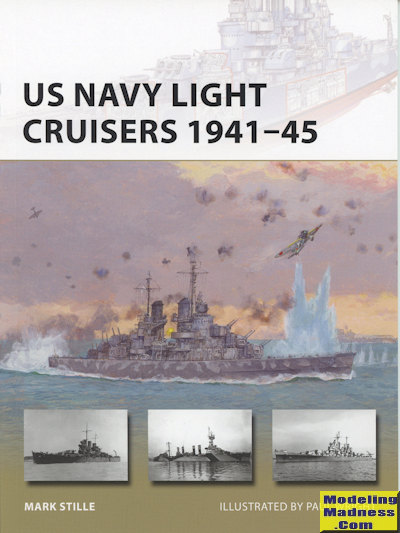 Allow
me to being this one by stating that the book is more encompassing than the
title may indicate. Coverage within the covers consists of ALL USN light
cruisers ever built. The Light Cruiser was an appellation that did not appear
until post WW 1 and went away once the last of the ships was scrapped. Before
that there were covered cruisers or armored cruisers or just plain cruisers. In
fact, the US Navy of the late 19th century was pretty much a cruiser navy, with
the armored cruisers basically being fast battleships.
Allow
me to being this one by stating that the book is more encompassing than the
title may indicate. Coverage within the covers consists of ALL USN light
cruisers ever built. The Light Cruiser was an appellation that did not appear
until post WW 1 and went away once the last of the ships was scrapped. Before
that there were covered cruisers or armored cruisers or just plain cruisers. In
fact, the US Navy of the late 19th century was pretty much a cruiser navy, with
the armored cruisers basically being fast battleships.
The original light cruisers in the US Navy were the Omaha class. These
were the result of WW 1 and though the first one wasn't laid down until Dec of
1918, ten were built. They were fast and provided what was needed for the time.
They were also quite crowded with one of the major issues being a lack of proper
toilet facilities! All saw service in WW 2, though mostly in secondary tasks
like convoy escort or shelling beaches. They were considered to be obsolescent
at the start of the conflict and were soon scrapped after the war.
US light cruisers were pretty much limited to 6 inch guns and the next
two classes, the Brooklyn and Atlanta classes would be considered 'Treaty
Cruisers'. The Atlanta class has 5 inch guns and were designed as destroyer
leaders, but found greater use as anti-aircraft cruisers, thanks to the 5/38
guns they carried.
By far the largest class of cruisers in the world were the Cleveland
class and the later Fargo class. The Cleveland light cruisers were built without
the restrictions of the various treaties. Many of these ships were converted
while under construction to light aircraft carriers and post war, many were
converted to missile cruisers. Quite a few were also sold or given to foreign
navies. One ship, the USS Phoenix, has the dubious distinction of being the only
ship ever sunk in action by a nuclear submarine. This occurred while she was the Belgrano in Argentine service and sunk during the Falklands War. Only one light
cruiser has been preserved and that is the USS Little Rock, a Cleveland class
ship that is a museum in Buffalo, NY.
The last class of light cruiser were the Worcester class. Only a few of
these were completed and like many of the late build Cleveland class, were
commissioned post-war and brief active duty lives.
Like other books in this series when it comes to ships, the author
covers the reason for them being designed and built, the weapons they carried as
well as their battle history. Each section on the various classes covers any
modifications made to the shipe during their service. Due to the sheer number of
ships covered, this material is succinct, but brief. There are superb photos and
illustrations provided to give one a sense of what these ships were like. If you
are a nautical modeler or a fan of ships, or just want to know more about these
vessels, I highly recommend picking this one up.
July 2016
Copyright ModelingMadness.com
For more on the complete line of Osprey books, visit
http://www.ospreypublishing.com
If you would like your product reviewed fairly and
fairly quickly, please
contact
the editor or see other details in the
Note to
Contributors.
 Allow
me to being this one by stating that the book is more encompassing than the
title may indicate. Coverage within the covers consists of ALL USN light
cruisers ever built. The Light Cruiser was an appellation that did not appear
until post WW 1 and went away once the last of the ships was scrapped. Before
that there were covered cruisers or armored cruisers or just plain cruisers. In
fact, the US Navy of the late 19th century was pretty much a cruiser navy, with
the armored cruisers basically being fast battleships.
Allow
me to being this one by stating that the book is more encompassing than the
title may indicate. Coverage within the covers consists of ALL USN light
cruisers ever built. The Light Cruiser was an appellation that did not appear
until post WW 1 and went away once the last of the ships was scrapped. Before
that there were covered cruisers or armored cruisers or just plain cruisers. In
fact, the US Navy of the late 19th century was pretty much a cruiser navy, with
the armored cruisers basically being fast battleships.